
We air an excerpt of the documentary, “Hotel Palestine: Killing the Witness,” produced by Jose Couso’s network, Telecinco, and broadcast on Spanish TV. It includes interviews with numerous journalists who were inside the Palestine Hotel, the AP reporter embedded with US forces at the time of the attack as well as the US tank commander who pulled the trigger. [includes rush transcript]
- “Hotel Palestine: Killing the Witness, excerpt of documentary.
Transcript
AMY GOODMAN: In a few minutes, we’ll hear from Javier Couso, the brother of Jose Couso who died in the attack. But first we turn to the documentary, Hotel Palestine: Killing the Witness. It includes interviews with numerous journalists who were inside the Palestine Hotel, the AP reporter embedded with U.S. forces at the time of the attack, as well as the U.S. tank commander who pulled the trigger. The documentary was produced by Jose Couso’s network in Spain, called Telecinco. It was broadcast on Spanish TV. This is an excerpt.
NARRATOR: Barely minutes after the attack and with almost no possibility of having contacted their forces still on the bridge, U.S. officials announced their first version of the incident.
VINCE BROOKS: Initial reports indicate that the coalition force operating near the hotel took fire from the lobby of the hotel and returned fire.
REPORTER: Continuing on the point you made there, if you are claiming fire was coming from the lobby of the Palestine Hotel, why was this tank round directed at an upper floor?
VINCE BROOKS: There’s intermingling that happens on the battlefield, and I don’t have enough information to say exactly how the dynamics of the battlefield came together today.
REPORTER: David Chater has been reporting to us by telephone during the extraordinary events.
NARRATOR: Journalists working at the Palestine Hotel categorically deny this version of events.
DAVID CHATER: They knew exactly that there were journalists here and that there were cameras pointing at the tank battle going on from these balconies. It’s extraordinary that they should come up with this excuse, saying that we have all got to hang white sheets out of the window to identify ourselves because there were sniper rounds coming out of the building. I never heard a single shot coming from any of the area around me, certainly not from the hotel.
CARLOS HERNANDEZ: [translated]All of us there knew there had been no hostile fire at all against the American tanks, neither from the hotel, nor from the hotel’s surroundings.
JESUS QUINONERO: [translated] I sat for about five hours, positioned on the hotel terrace. I heard no shooting from our side. Not from our side. None at all.
NARRATOR: There is an obvious fact that contradicts this first version from the U.S. forces. More than 1,500 meters separate the Palestine Hotel and the tanks, far beyond the effective range of a rifle or a rocket-propelled grenade launcher. Associated Press correspondent Chris Tomlinson was embedded with the second battalion of the third infantry division.
CHRIS TOMLINSON: I think that was something that the soldiers started to say after the fact to try to protect themselves from criticism. But as you pointed out, if you go stand where the tank was and look at where the Palestine is, there’s no — an RPG cannot fire that far, a sniper rifle may be able to reach that far. AK47s certainly can’t shoot that far.
NARRATOR: We visit Fort Stewart in Georgia, headquarters of the third infantry division. Our team is interested in seeing an Abrams tank from the inside. The crews are checking the armored tanks that took part in the war. Sergeant Pyle explains in detail the capacities and qualities that make the Abrams a virtually invulnerable weapon of war.
JEROLD PYLE: This thing weighs 70 tons, and is pretty much from the front especially impenetrable. If somebody shoots at us from the front, it’s not coming through. We did have tanks that were — the suspension was hit. We had tanks that the engines were hit, but the crews were not.
NARRATOR: The 120 millimeter cannon is not its only weapon. To handle the threat of a sniper hidden in a building, it could or should use a less destructive weapon.
JEROLD PYLE: If you were just taking fire from a point, from a single place, we would use the machine guns and try not to cause any further collateral damage.
NARRATOR: These are the sites through which the tank commander and the gunner identify the target. The precise distance is calculated by a laser guide. A target located 1,500 meters away can be clearly identified.
JEROLD PYLE: He can identify day or night out to about the maximum range of the weapon system, out about two-and-a-half miles.
INTERVIEWER: Two-and-a-half miles. That would be an accurate target for you.
JEROLD PYLE: If you can see it, you can hit it.
NARRATOR: Sergeant Shawn Gibson commands one of the tanks that on April 8 would take positions on the Al-Jumhuriya Bridge. He would be the one to fire on the Palestine Hotel. His tank carries the flag of Captain Wolford’s company. One of his soldiers has no problem in showing it: a skull with two crossed swords. On the left, their nickname, “The Assassins.” Days after the attack, Gibson agrees to talk to a team from Belgian public television.
PASCALE BOURGAUX: [translated] It was easy to find them, but difficult to convince them. The argument that I used was if this goes to court and the affair gets complicated, the most probable result is that the chiefs of staff will lay the blame on you.
SHAWN GIBSON: I was receiving artillery rounds up there in front of my tank, beside my tank, up under my tank. They were shooting up under my tank with RPGs on the bridge. You go over to the bridge right now, you will see holes up under the bridge where my tank was sitting.
PASCALE BOURGAUX: [translated]And at one point, he stops the interview.
SHAWN GIBSON: Want to go look at my tank and see the shots on my tank? Come on, let’s take a look at that. Come on.
PASCALE BOURGAUX: Wait, wait, wait, finish the — no.
PASCALE BOURGAUX: [translated] He tells me, I’ll show you my tank, how we were attacked. He takes me all around the tank, and shows me the holes, from all kinds of artillery.
SHAWN GIBSON: See, they shot my grenade launcher.
PASCALE BOURGAUX: [translated] At that point of the interview, he was almost angry at having to explain the battle on the bridge to me.
NARRATOR: Weeks later, on the bridge, we still find evidence of the battle, although not as much as Gibson asserted. The damaged bridge railing, the impact of rocket propelled grenades. Other traces reveal the tank’s decisive response to attack. Enough to make a hole in this lamp post when they fire on the Ministry of Telecommunications. On April 8, cameras at the Palestine Hotel film how one of the tanks located behind the bridge is hit. But above all, they see the armored tanks reply to fire with their full power again and again and always straight at this building, the Ministry of Youth. That is where the Fedayeen have taken up positions from a nearby building. An old janitor soon watches them flee.
JANITOR: [translated] They all ran away. There was no one left. The ministry was empty. But before that, there was major resistance.
NARRATOR: From the Palestine Hotel, journalists can see the bridge, but not the areas from which the tanks are fired upon. The U.S. troops fire continuously on the other side of the river. They’re being attacked from an area to the left of the bridge and from the Ministry of Youth, 1,500 meters away from the hotel. If, according to the official explanation, they were being attacked from the Palestine Hotel, why did they only fire a single round in that direction throughout the entire morning? At this point, the official version evolves to include the spotter theory.
CHRIS TOMLINSON: It was at that point that Captain Wolford’s men had captured an Iraqi prisoner who had a radio. They were monitoring — they had an Arab linguist — an Arab American listening to the radio, listening to what they call a “forward observer,” someone calling in the mortar fire and directing the infantrymen in their attack against Captain Wolford’s forces.
SHAWN GIBSON: Then I went to scan higher. I started going by the floors. I seen no one until I get to the upper third floor. I see somebody up there with a pair of big binoculars, and I see them pointing.
JON SISTIAGA: All war correspondents carry binoculars for just that kind of a thing. To spot a tank two kilometers away, and to tell the cameraman that there is a tank over there.
CARLOS HERNANDEZ: [translated] It was simply ridiculous that they should think that the tank position coordinates were actually being given from the hotel. You could see the tanks from just about anywhere in the city.
NARRATOR: Did Gibson see a journalist with binoculars and think he was an enemy spotter? It could be an excuse, but surprisingly, the sergeant goes on to assert that there were no journalists on the balconies.
PASCALE BOURGAUX: You didn’t see it was a camera?
SHAWN GIBSON: There was no camera. I seen binoculars.
PASCALE BOURGAUX: The camera on the balconies.
SHAWN GIBSON: Like this one? Negative. A person don’t stand like this with two hands in front of their eyes with just a camera. Okay? I seen two lenses and their hands up holding it. It looked like binoculars to me.
AMY GOODMAN: Tank commander Shawn Gibson from the documentary, Hotel Palestine: Killing the Witness. We’ll continue with it in a minute.
[break]
AMY GOODMAN: This is Democracy Now!, democracynow.org, the War and Peace Report. I’m Amy Goodman, as we continue with Telecinco network’s Hotel Palestine: Killing the Witness. This is journalist Carlos Hernandez from the Spanish network Antena 3.
CARLOS HERNANDEZ: The shell hit room 1503, the Reuters room, and all the rooms above, below, to the right and to the left were occupied by colleagues, journalists whom we knew personally.
NARRATOR: Boston Herald correspondent Jules Crittenden, embedded in the tank company, maintains that the main fighting lasted six hours from 4:00 a.m. to 10:00 a.m. That is, the combat ended two hours before the attack on the Palestine Hotel. Jose Couso’s last tape is 24 minutes long and begins with this footage. During the first nine minutes, his camera films the tanks firing 18 times. And finally, in the last 15 minutes, they fire once. Just once.
PAUL PASQUALE: When I sat down with Taras, it was quiet, there was no tension in the air. There was probably less tension in the air then — less tension, less worry — than there had been in the previous days when the bombing was going on.
CARLOS HERNANDEZ: [translated] At that point, we were relatively calm. We had already filmed everything that there was to film. The tanks had stopped. There was no fighting, and for some time, we had heard no shots being fired.
NARRATOR: Gibson swings his cannon towards the hotel and requests Captain Wolford’s permission to fire, but he still hesitates.
SHAWN GIBSON: And I still hesitated. Do you hear me? I hesitated.
PASCALE BOURGAUX: I know.
SHAWN GIBSON: Okay? And I took my time, and I called it up to ensure what I seen, and it was clarified with another set of eyes.
NARRATOR: The decision was not taken in the heat of battle. Ten minutes go by until Gibson receives the order to open fire.
SHAWN GIBSON: We did not know that they had reporters in the Palestine Hotel. If we would have known that, we would not have fired a round over there. I don’t even know if that information was given to the U.S. Army. I do not know that. Okay? If it was, it didn’t get down to my level.
CHRIS TOMLINSON: What Colonel Perkins and Colonel DeCamp have told me is that they did not have any information about the Palestine Hotel or the location of western journalists prior to coming into Baghdad on April 7.
NARRATOR: When Colin Powell visits Spain on May 2, he confirms what everyone had assumed. The military command was perfectly aware that the journalists were based at the Palestine Hotel.
COLIN POWELL: We knew about the hotel. We knew that it was a hotel where journalists were located, and others, and it is for that reason it was not attacked during any phase of the aerial campaign.
NARRATOR: The generals monitoring the fighting from their headquarters in Qatar soon watched the incident broadcast worldwide on television and called Baghdad demanding an explanation.
CHRIS TOMLINSON: That image got out on satellite television and their senior commanders at the two and three-star general level, messaged them and said, what are you doing shooting the Palestine Hotel?
NARRATOR: Tomlinson overhears radio communications discussing the incident. Lieutenant Colonel DeCamp is informed of the attack by his superiors and shouts over the radio.
LIEUTENANT COLONEL DECAMP: Who just shot the Palestinian Hotel?
NARRATOR: Tomlinson hears how DeCamp, clearly upset, asks Wolford:
LIEUTENANT COLONEL DECAMP: Did you just shoot the Palestinian Hotel?
CHRIS TOMLINSON: The way he asked the question was a little misleading. When he asked Captain Wolford, did you shoot the Palestine Hotel, he assumed knowledge that Captain Wolford didn’t have.
SHAWN GIBSON: I wish it would have never happened, but it has happened. And I pray to God and I ask God for his forgiveness, and my sincere apologies and grievances to their families. It was not done intentionally.
CHRIS TOMLINSON: There was the sense throughout the chain of command, from Perkins to DeCamp to Wolford, all the way down to Shawn Gibson that they had done something very bad. I can tell you that Captain Wolford was visibly upset when I saw him, an hour — two hours later. He was very upset about it. Sergeant Gibson is very upset about it. Colonel DeCamp obviously was very angry, he was upset.
NARRATOR: Spanish journalists are not as understanding as Tomlinson about the military officer’s behavior. The three attacks on journalists on April 8 lead them to think that U.S. forces did not want witnesses.
JON SISTIAGA: [translated] What’s my opinion? My opinion is that there was a deliberate intent to fire on the journalists’ hotel.
JOURNALIST: [translated] So, they had to know perfectly well where we were, and there was no mistake. There could be no mistake.
JON SISTIAGA: [translated] First, they get rid of the offices of Al-Jazeera TV, half an hour later, they shoot the offices of Abu Dhabi TV, and half an hour after that, the same tank, why not, shoots at the hotel where other international journalists are staying.
JOURNALIST: [translated] I don’t know to what extent the Americans knew that the final stages of the war would be so easy for them.
JON SISTIAGA: [translated]And what they did not want under any circumstances was almost 300 journalists, non-American, and not under their control, that is, that would not exercise patriotic self-censorship, ready to cover whatever might happen.
CHRIS TOMLINSON: There were breakdowns at several levels. One, the Pentagon did not inform the chain of command about the Palestine Hotel, its location, and what to look for. And they had assured journalists that they had done that. And that, I think, is probably the biggest error that was made.
PAUL PASQUALE: Was it a colonel that didn’t inform a major, and a major that didn’t inform an officer, and an officer that didn’t inform a sergeant who didn’t inform the guy who pressed the trigger? No answers.
NARRATOR: In Spain, journalists express their anger to the government, and announce that a war crime has been committed. In Congress, they place themselves in front of Prime Minister Aznar’s seat with Couso’s portrait. The Spanish government defines the attack on the hotel as an unfortunate event, a mistake or a tragedy but never dares to criticize the U.S. armed forces. The Spanish government, uncritically accepts all of the explanations given by Washington. President Bush himself is personally forced to address the subject when Spanish Prime Minister Aznar visits the White House. Visibly annoyed, he dispatches the reporter’s question with barely 15 words.
REPORTER: [translated] President Bush, you have offered your condolences to the families of the two Spanish journalists who died in the Iraq war. I’d like to ask you, do you think that it was a mistake when the U.S. Army fired on the Palestine Hotel where Jose Couso was killed, and if that’s the case, will you apologize to the Spanish government and to Couso’s family for his death?
PRESIDENT GEORGE W. BUSH: I think war is a dangerous place.
AMY GOODMAN: That was President Bush, an excerpt from the documentary, Hotel Palestine: Killing the Witness. It was produced by Telecinco Spanish Television, the network of Jose Couso, who died on April 8, 2003, when the U.S. military attacked the Palestine Hotel.

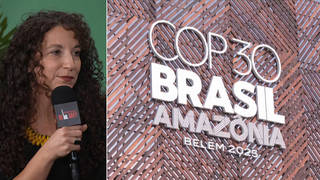
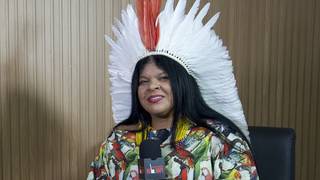
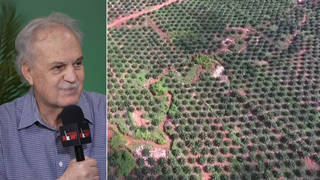
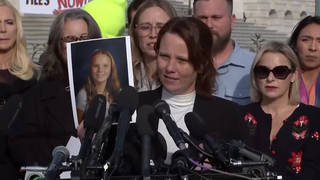





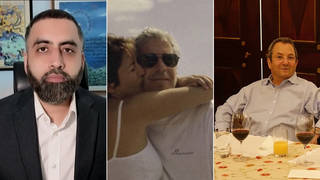
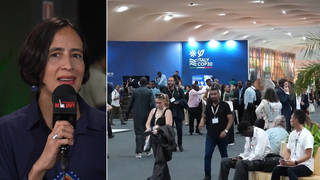
Media Options